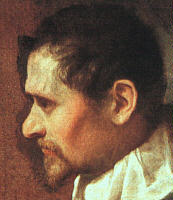
|
Annibale, born in Bologna on November 3, 1560, was the most important member of an influential family of painters that included his elder brother Agostino and their cousin Lodovico. In 1585 they established the Accademia degli Incamminati, a painting school with the avowed purpose of reforming art by retrieving the classical principles of the High Renaissance masters, as exemplified in the work of artisits Michelangelo and Raphael. The academy attracted such promising young painters as Alessandro Algardi, Domenichino, and Guido Reni, making Bologna one of the most active and influential Italian art centers for over two decades. Annibale, with the design and execution of such noble fresco series as the lyrical Romulus cycle (1588-1592), in Bologna's Palazzo Magnani, was soon recognized as the most gifted of the Carracci family. Among his oil paintings of this period are The Butcher's Shop (1583?, Christ Church, Oxford, England) and The Assumption (1587, GemÄldegalerie, Dresden, Germany).
Annibale was summoned to Rome in 1595 to decorate the state apartments of the Palazzo Farnese, the city's most splendid new private palace. He began his masterpiece, the magnificent illusionistic ceiling frescoes in the Galleria (a gallery) in 1597. Against a painted architectural background representing stucco heroic nudes, bronze plaques, and carved marble decorations are set what appear to be 11 huge easel paintings in ornate frames. They depict, in idealized human form, love scenes of the pagan gods, derived from the Roman poet Ovid's fables. Finished by 1604, the frescoes astounded Rome's artistic world. They were extravagantly praised by such baroque artists as the Italian master Gian Lorenzo Bernini and the Flemish painter Peter Paul Rubens; both freely acknowledged the powerful influence of the Farnese frescoes on their own art.
Despite the urging of his devoted assistants, including his chosen artistic successor Domenichino, Annibale undertook few commissions after this monumental work. Outstanding are his subtle and exquisite landscapes, as in Sacrifice of Isaac (Louvre, Paris, France), which directly presage the neoclassical landscapes of the French painters Claude Lorrain and Nicolas Poussin. He contracted a form of paralysis in 1605, and died in Rome July 15, 1609.
|

